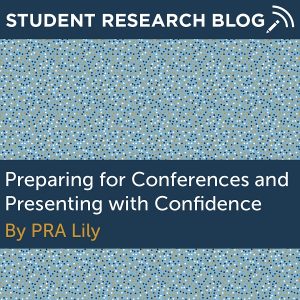By Lily Zhong, Peer Research Ambassador
It can be intimidating to create a poster for the first time and even more nerve wracking to present your poster to others at a professional conference. I have experienced all these anxieties myself when preparing and presenting for the annual NEURON conference at Frank H. Netter MD School of Medicine and multiple Frontiers in Undergraduate Research Exhibitions as well. Here are a few things to keep in mind that helped me stay calm and present with confidence.
In terms of preparing for conferences, a great place to start is coming up with the message you want to convey. Starting backwards helped me structure my poster because I had a ‘big picture’ goal in mind as I prepared. Next, I worked on selecting and creating figures that would aid in delivering my message clearly. After making sure my figures and legends were clear and concise, I proceeded to describe the results shown in my figures and touch upon their significance. The last thing I did was write my introduction, which may seem counterintuitive; however, by completing the other detailed sections first and keeping my overall message in mind, writing my introduction was much easier since I just had to summarize my work and put it into context. One important thing to keep in mind is that it is more than okay to ask for help. Your mentors, whether it be your PI or a graduate student, have plenty of experience with poster presentations and I am sure would be more than happy to assist you.
Now that you feel confident in the quality of your poster, you are ready to think about how you can present your work effectively. The best place to start is identifying your audience. For me, it was undergraduate and graduate students who either understood a lot about the field I was discussing, or were entirely new to the field. This meant I needed to prepare my presentation to cater towards both audiences. I had a more detailed seven to eight minute explanation of my work and a more broad five minute overview. After identifying my audience and determining a general timeframe for presenting my poster, I then practiced over and over. I created a few bulleted ideas of the most important things I wanted to touch upon, and then practiced until I could talk naturally and confidently about my work. Lastly, make sure you show the passion you have for your work! If you are not excited about the poster, your audience will likely not be either.
In addition to preparing and presenting, most professional conferences also include networking events. These events are an incredible way to meet others in the field with similar interests as you, or even learn about topics you had never thought of studying. While it may seem overwhelming to put yourself out there, it is the perfect opportunity to step outside your comfort zone and surprise yourself by who you meet and how much you can learn.
I hope that by now the idea of preparing and presenting your work may not be as daunting as it seems. If you break it up into small portions and tackle one task at a time as described above, the entire experience can be very rewarding.
Lily is a senior majoring in Physiology & Neurobiology and minoring in English. Click here to learn more about Lily.